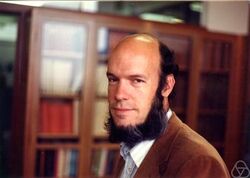Biography:David Siegmund
David O. Siegmund | |
|---|---|
 | |
| Born | November 15, 1941 St. Louis, Missouri, US |
| Alma mater | Columbia University |
| Scientific career | |
| Fields | Statistics |
| Institutions | Stanford University |
| Doctoral advisor | Herbert Robbins |
| Doctoral students | |
David Oliver Siegmund (born November 15, 1941)[1] is an American statistician who has worked extensively on sequential analysis.[2]
Biography
Siegmund grew up in Webster Groves, Missouri. He received his baccalaureate degree, in mathematics, from Southern Methodist University in 1963, and a doctorate in statistics from Columbia University in 1966. His Ph.D. advisor was Herbert Robbins. After being an assistant and then a full professor at Columbia, he went to Stanford University in 1976, where he is currently a professor of statistics. He has served twice as the chair of Stanford's statistics department.[2][3] He has also held visiting positions at Hebrew University of Jerusalem, the University of Zurich, the University of Oxford, and the University of Cambridge.[2]
Work
Siegmund has written with Herbert Robbins and Yuan-Shih Chow on the theory of optimal stopping. Much of his work has been on sequential analysis, and he has also worked on the statistics of gene mapping.[2]
Awards and honors
- Guggenheim Fellowship (1974)
- Humboldt Prize (1980)
- Elected to the American Academy of Arts and Sciences (1994)
- Invited Speaker of the International Congress of Mathematicians (1998)[4]
- Elected to the National Academy of Sciences (2002)[2]
Selected publications
- (with Y. S. Chow and H. Robbins) Great Expectations: The Theory of Optimal Stopping, Boston: Houghton Mifflin, 1971.
- (with Rupert Miller) Maximally Selected Chi Square Statistics, Biometrics, 38, #4 (December 1982), pp. 1011–1016.
- Sequential Analysis: Tests and Confidence Intervals, New York: Springer, 1985, ISBN:0-387-96134-8.
- (with John D. Storey and Jonathan E. Taylor) Strong control, conservative point estimation and simultaneous conservative consistency of false discovery rates: a unified approach, Journal of the Royal Statistical Society, Series B 66, #1 (February 2004), pp. 187–205, doi:10.1111/j.1467-9868.2004.00439.x.
References
- ↑ p. 114, Reports of the president and of the treasurer, John Simon Guggenheim Memorial Foundation, 1974.
- ↑ 2.0 2.1 2.2 2.3 2.4 Biography of David O. Siegmund, David Appell, Proceedings of the National Academy of Sciences 101, #21 (May 25, 2004), pp. 7843–7844, doi:10.1073/pnas.0402953101.
- ↑ David O. Siegmund, home page at Stanford University. Accessed on line September 17, 2010.
- ↑ Siegmund, David (1998). "Genetic linkage analysis: An irregular statistical problem". Doc. Math. (Bielefeld) Extra Vol. ICM Berlin, 1998, vol. III. pp. 291–300. https://www.elibm.org/ft/10011586000.
External links
- David O. Siegmund, home page at Stanford
- David Siegmund at the Mathematics Genealogy Project
 |

